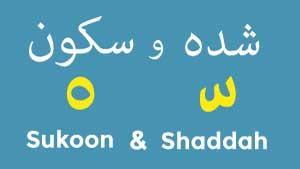Previous ➥ Lesson 5 ➥ Next
Sukoon
- What is sukoon in Arabic?
- Examples of Arabic Sukoon symbol
- Arabic diphthongs
- Comparison between long vowels and diphthongs
- Exercise
What is sukoon in Arabic?
The Arabic word Sukoon سُكُون
The sukoon symbol represents an absence of the vowel on a letter. It means the letter is in a still position (no Harakat حَرَکَات
In fact, we have already learned Sukoon in the last lesson (long vowels) without showing it on the letters.
بِ + ي ⇜ بِي
بُ + و ⇜ بُو
Here, letters ي and و are without vowels, (because they themselves are vowels) so, we can give sukoon symbols to these two letters.
بِ + ي ⇜ بِيْ
بُ + و ⇜ بُوْ
However, in the case of long vowel ا, we can't put the sukoon symbol on it.
بَ + ا ⇜
بَاْ
The normal role of Sukoon symbol is to cut the sound of the letter on which it is placed. Play the following two sounds to feel the difference.
بَا
بَاْ
“
The reason for the difference in sounds of بَا and بَاْ is that letter ا in the word بَا is the long vowel "aa" but the letter اْ in the word بَاْ is actually the letter "hamza" (ء). The letter hamza (ء) is explained in the separate lesson.
In some scripts, اْ is written as
أْ. As discussed earlier, long vowels
ي
and و
have no change in their sound whether the "sukoon" symbol is placed on them or not. Now we know that اْ and
ا
are two different letters ( اْ ≠ ا ) and we know the reason why we can't place sukoon symbol on the long vowel
ا.
This concept would become more clear after the lesson, Hamza in Arabic.
”
The letter on which the Sukoon symbol is placed is called Sakin
In cases of long vowels
ـِ + ي and
ـُ + و the Sukoon symbol plays an exceptional role and doesn't cut the voices. For all other letters, including the long vowel
ـَ + ا, the letter with the Sukoon symbol shows no movement (a cut or break in the sound).
Please see the below examples for more clarity. (The following words may not be meaningful Arabic words. They are just presented to explain the sound of Sukoon.)
Examples of Arabic Sukoon symbol
اَبْ
اِبْ
In previous lessons, we have been using harakat (vowels) along with letters (consonants), which makes learning to read Arabic easy for beginners. We can also read sukoon in the same manner.
We have two ways to read sukoon:
اَبْ
Alif-ftah-ba⇝ab
A more detailed method:
اَبْ
Alif-ftah-ba-sakin⇝ab
We are going to use the second, more detailed method to read in this lesson. If you like, you can omit the word "sakin".
اُبْ
بَاْ
تَاْ
ثَاْ
ثُاْ
اَتْ
اَثْ
اَجْ
بَحْ
بَخْ
بَدْ
بَذْ
بَرْ
بِرْ
بَزْ
اَسْ
اَشْ
بَصْ
بَضْ
بَطْ
بَظْ
اَعْ
اَعْتَغْ
اَغْ
اُفْ
اُفْدَقْ
اَبْكَا
اَكْبَا
اِقْتِبَاسُ
اِجْلَاسُ
عِمْرَانُ
اِنْسَانُ
اَهْلُ
Arabic diphthongs
In all the above examples, we haven't seen a word with combinations
ـَ + ي
or
ـَ + و.
This is because the sukoon symbol ـْ on letters
و and ي doesn't cut or break the sound of the letter.
From the early discussion, we know that even if we place the sukoon symbol ـْ on the long vowels ـُ + و and ـِ + ي, the sound remains the same (no cut or break in the sound).
Similarly, in case of combinations ـَ + ي
or
ـَ + و, sounds remain uncut. The combinations ـَ + ي and ـَ + و are two diphthongs in the Arabic language.
Below are some example words with diphthongs combinations.
ـَ + وْ
ـَ + يْ
اَوْ
اَيْ
بَوْ
بَيْ
تَوْ
تَيْ
ثَوْ
ثَيْ
جَوْ
جَيْ
دَوْ
دَيْ
رَوْ
رَيْ
زَوْ
زَيْ
سَوْ
سَيْ
صَوْ
صَيْ
ضَوْ
ضَيْ
طَوْ
طَيْ
ظَوْ
ظَيْ
غَوْ
غَيْ
فَوْ
فَيْ
قَوْ
قَيْ
كَوْ
كَيْ
لَوْ
لَيْ
مَوْ
مَيْ
Comparison between long vowels and diphthongs
The following table compares the sound difference between long vowels and diphthongs.
Please note that in long vowels, the letter
و and
ي
may have sukoon symbol
ـْ
or may not. Both ways are correct.
|
Diphthongs
⇜ |
Long vowels
⇜ |
|---|---|
|
اَوْ
|
اُو/ اُوْ
|
|
اَيْ
|
اِي/ اِيْ
|
|
بَوْ
|
بُو/ بُوْ
|
|
بَيْ
|
بِي/ بِيْ
|
|
تَوْ
|
تُو/ تُوْ
|
|
تَيْ
|
تِي/ تِيْ
|
|
حَيْ
|
حِي/ حِيْ
|
|
صَاﻟِﺤَﻴْنِ
|
صَاﻟِﺤِﻴنَ/
صَاﻟِﺤِﻴْنَ
|
|
مَيْ
|
مِي/ مِيْ
|
|
مُسْلِمَيْنِ
|
مُسْلِمِينَ/ مُسْلِمِيْنَ
|
|
كَيْ
|
كِي/ كِيْ
|
|
مُشْرِكَيْنِ
|
مُشْرِكِينَ/ مُشْرِكِيْنَ
|
Generally, in scripts written for native Arabic speakers, long vowel combinations ـُ + و and ـِ + ي are written without sukoon symbols on و and ي, e.g. مُسْلِمِينَ.
In scripts written for non-Arabic speakers, like Mushafs of Quran and books of Hadees for non-native speakers, long vowel combinations have sukoon symbols on them, i.e. ـُ + وْ and ـِ + يْ, e.g. مُسْلِمِيْنَ.
Just to stick with one syntax, from now on we will be using the sukoon symbol with long vowels in all coming lessons.
ـَ + ا
ـِ + يْ
ـُ + وْ
Exercise
- Try to pronounce the following words without listening to the given sounds and compare them with sounds.
- Write the following words on a separate paper.
- Extract vowels and diphthongs from the following words.
- Show answer button is given at the end of the exercise.
مُسْلِمَتَانِ
تَا
مُسْلِمَتَيْنِ
تَيْ
هَاتَانِ
هَا ، تَا
مُسْلِمُوْنَ
مُوْ
فَاسِقُوْنَ
فَا ، قُوْ
كِتَابُهَا
تَا ، هَا
اَبُوْهُمَا
بُوْ ، مَا
اَخُوْهَا
خُوْ ، هَا
بَيْتُكُمْ
بَيْ
مَسَاجِدُ
سَا
جَامُوْسُنَا
جَا ، مُوْ، نَا
هٰذَا
هَا ، ذَا
كَيْدُكُمْ
كَيْ
Previous ➥ Lesson 5 ➥ Next

